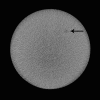Noise-reducing algorithms do not necessarily provide superior dose optimisation for hepatic lesion detection with multidetector CT
- PMID: 23392194
- PMCID: PMC3608061
- DOI: 10.1259/bjr.20120500
Noise-reducing algorithms do not necessarily provide superior dose optimisation for hepatic lesion detection with multidetector CT
Abstract
Objective: To compare the dose-optimisation potential of a smoothing filtered backprojection (FBP) and a hybrid FBP/iterative algorithm to that of a standard FBP algorithm at three slice thicknesses for hepatic lesion detection with multidetector CT.
Methods: A liver phantom containing a 9.5-mm opacity with a density of 10 HU below background was scanned at 125, 100, 75, 50 and 25 mAs. Data were reconstructed with standard FBP (B), smoothing FBP (A) and hybrid FBP/iterative (iDose(4)) algorithms at 5-, 3- and 1-mm collimation. 10 observers marked opacities using a four-point confidence scale. Jackknife alternative free-response receiver operating characteristic figure of merit (FOM), sensitivity and noise were calculated.
Results: Compared with the 125-mAs/5-mm setting for each algorithm, significant reductions in FOM (p<0.05) and sensitivity (p<0.05) were found for all three algorithms for all exposures at 1-mm thickness and for all slice thicknesses at 25 mAs, with the exception of the 25-mAs/5-mm setting for the B algorithm. Sensitivity was also significantly reduced for all exposures at 3-mm thickness for the A algorithm (p<0.05). Noise for the A and iDose(4) algorithms was approximately 13% and 21% lower, respectively, than for the B algorithm.
Conclusion: Superior performance for hepatic lesion detection was not shown with either a smoothing FBP algorithm or a hybrid FBP/iterative algorithm compared with a standard FBP technique, even though noise reduction with thinner slices was demonstrated with the alternative approaches.
Advances in knowledge: Reductions in image noise with non-standard CT algorithms do not necessarily translate to an improvement in low-contrast object detection.
Figures
References
-
- European Commission Council Directive 97/43/Euratom of 30 June 1997, on health protection of individuals against the dangers of ionizing radiation in relation to medical exposure, and repealing Directive 84/466/Euratom. Official Journal of the European Communities: L, Legislation, vol 180. 1997. pp. 22–7
-
- Brenner DJ, Hall EJ. Computed tomography—an increasing source of radiation exposure. N Engl J Med 2007;357:2277–84 - PubMed
-
- Berrington de Gonzalez A, Darby S. Risk of cancer from diagnostic X-rays: estimates for the UK and 14 other countries. Lancet 2004;363:345–51 - PubMed
-
- Brenner D, Elliston C, Hall E, Berdon W. Estimated risks of radiation-induced fatal cancer from pediatric CT. AJR Am J Roentgenol 2001;176:289–96 - PubMed
-
- United Nations Scientific Committee. UNSCEAR. 2000 The United Nations Scientific Committee on the Effects of Atomic Radiation. Health Phys 2000;79:314 - PubMed
Publication types
MeSH terms
LinkOut - more resources
Full Text Sources
Other Literature Sources
Medical
Miscellaneous



